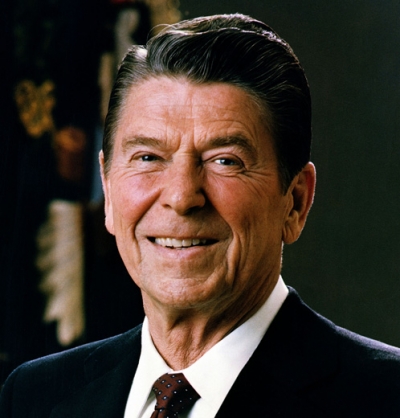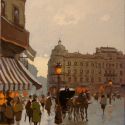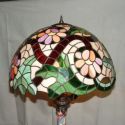
photo: http://www.visitingdc.com/images/ronald-reagan-picture.jpg
Biography
For other uses, see Ronald Reagan (disambiguation).
Ronald Wilson Reagan
Order
40th President
President from
January 20, 1981 – January 20, 1989
Vice President
George H. W. Bush
Preceded by
Jimmy Carter
Succeeded by
George H. W. Bush
Born
February 6, 1911
Tampico, Illinois
Died
June 5, 2004
Bel-Air, California
Political party
Republican
Spouse
(1) Jane Wyman (divorced) (2) Nancy Davis Reagan
Ronald Wilson Reagan (February 6, 1911 – June 5, 2004) was the 40th President of the United States (1981–1989) and the 33rd Governor of California (1967–1975). Before entering politics, Reagan was also a sports broadcaster, newspaper columnist, motion picture actor, head of the Screen Actors Guild, television actor, and a motivational speaker. His speeches were so expertly delivered and persuasive that the media dubbed him the "Great Communicator".
Reagan was the victim of an assassination attempt on March 30, 1981. He was the only U.S. President to be struck by an assassin's bullet while in office as President and survive.
Reagan defeated incumbent President Jimmy Carter to win the election in 1980, carrying along the first Republican-dominated U.S. Senate in 26 years. His economic policy of supply-side economics, popularly known as "Reaganomics" is noted for a 25% cut in the income tax, reduction in inflation, reduction in interest rates, increased military spending, increased deficits and national debt, a temporary solution to the Social Security issue, elimination of loopholes in the tax code, continued deregulation of business, a sharp recession in 1981-1982 followed by a very robust economic expansion starting in '82. In other domestic issues he failed in his efforts to significantly change social policies such as welfare and abortion, but he did move the federal judiciary to the right through appointments to the Supreme Court and other federal courts. From beginning to end he emphasized his skepticism concerning the ability of the federal government to remedy problems.
Both his supporters and many opponents credit him for restoring psychological optimism to an America that seemed in deep malaise in 1980. In foreign policy his administration is noted for the vast buildup of the military and change from containment of the Soviet Union to confrontation. Reagan was committed to the ideologies of democratic capitalism and anti-communism. He is considered by hundreds of historians, political scientists and analysts in Russia and the West to be a leading figure in orchestrating the collapse of Soviet Communism in 1991. [See Busch 1993; Summy and Salla 1995] There is no controversy regarding his dominant position in the emergence of the American conservative movement. He was reelected in a landslide in the 1984 presidential election, and left office even more popular than when he began. The inability of the numerous scandals during his tenure, including the Iran-Contra Affair, the bombing in Beirut, and convictions of officials in his administration, to negatively impact his approval ratings earned him the nickname, "Teflon President." The decade of the 1980s is sometimes referred to as the "Reagan Eighties."
He received a state funeral after his death in Bel-Air, California in 2004 at the age of 93, after suffering from Alzheimer's disease for a decade.
Contents
1 Early life and career
1.1 Hollywood
2 Marriages
3 Early political career
4 Governorship
5 Presidential campaigns
6 Presidency 1981-1989
6.1 Domestic policies
6.2 Foreign policy and interventions
6.3 "The Great Communicator"
6.4 Assassination attempt
6.5 Criticism
6.6 Major legislation approved
6.7 Administration and Cabinet
6.8 Supreme Court appointments
7 Religious beliefs
8 Post Presidential years
8.1 Alzheimer's Disease
9 Legacy
9.1 Job approval rating
9.2 Death
9.3 Nicknames
10 Honors
10.1 Awards and decorations
11 Coinage
12 Reagan documentaries
13 See also
14 Further reading
14.1 Secondary sources
14.2 Primary sources
14.3 Notes
15 External links
15.1 Biographical information
15.2 Speeches and interviews
15.3 Multimedia links
Early life and career
Reagan was born on February 6, 1911, in an apartment above a small bakery in Tampico, Illinois. He was the second of two sons to John "Jack" Reagan, a Catholic of Irish American ancestry, and Nelle Wilson, who was of Scots-Irish and English descent. His paternal great-grandfather, Michael Reagan, came to the United States from Ballyporeen, County Tipperary, Ireland in the 1860s. Prior to his immigration, the family name was spelled Regan. His maternal great-grandfather, John Wilson, immigrated to the United States from Paisley, Scotland in the 1840s.
In 1920, after years of moving from town to town, the family settled in Dixon, Illinois. In 1921, at the age of 10, Reagan was baptized in his mother's Disciples of Christ church in Dixon (although his brother, Neil, became a Catholic, like his father). In 1924 Ronald Reagan began attending Dixon's Northside High School. Reagan always considered Dixon to be his hometown.
Ronald and his older brother Neil, with parents Jack and Nelle Reagan. (ca. 1916-1917)
In 1927, at age 16, Reagan took a summer job as a lifeguard in Lowell Park, two miles away from Dixon on the nearby Rock River. He continued to work as a lifeguard for the next seven years, reportedly saving 77 people from drowning. Reagan would later joke that none of them ever thanked him. In future years, he would point to that achievement, proudly showing visitors a picture of Rock River in the Oval Office.
In 1928, Reagan entered Eureka College in Eureka, Illinois, majoring in economics and sociology, and graduating in 1932. As a freshman he participated in a student strike against the downsizing of the faculty that was lead by Leslie Pierce, the president of Reagan's pledged fraternity. In the end the college president resigned, but his downsizing went forward. In 1929 Reagan joined the Tau Kappa Epsilon fraternity which he later recalled as one of the greatest experiences he had during his college years. He rarely studied and earned mediocre grades, but was "Big Man on Campus" as leader of numerous clubs and sports groups, and as student body president he made many lasting friendships.
Reagan developed an early gift for storytelling and acting. These abilities led to his selection as one of the freshman speakers during the late-night meeting prior to the student strike at Eureka. His first notable job was at a Des Moines radio station as an announcer for Chicago Cubs baseball games, getting only the bare outlines of the game from a ticker and relying on his imagination to flesh out the game. Once, during the ninth inning of a game, the wire went dead but Reagan smoothly improvised a fictional play-by-play (in which hitters on both teams fouled off numerous pitches) until the wire was restored.
Hollywood
In 1937, when in California to cover spring training for the Chicago Cubs as a Headline radio announcer, Reagan took a screen test that led to a seven-year contract with the Warner Brothers studio. Reagan's clear voice, easy-going manner, and athletic physique made him popular with audiences; the majority of his screen roles were as the leading man in B movies. His first screen credit was the starring role in the 1937 movie Love Is On the Air. By the end of 1939, he had appeared in 19 films. Before Santa Fe Trail in 1940, he played the role of George "The Gipper" Gipp in the film Knute Rockne, All American. From this role he acquired the nickname the Gipper, which he retained the rest of his life. Reagan considered his best acting work to have been in Kings Row (1942). He played the part of a young man whose legs were amputated. He used a line he spoke in this film, "Where's the rest of me?", as the title for his autobiography. Other notable Reagan films include Hellcats of the Navy, This Is the Army, and Bedtime for Bonzo. Reagan was kidded widely about the last named film because his co-star was a chimpanzee. He has a star on the Hollywood Walk of Fame.
Nancy and Ronald Reagan married in 1952. Nancy Reagan became a powerful and important background advisor in Reagan's campaigns and administrations
Reagan was commissioned as a reserve officer in the United States Army in 1935. After the attack on Pearl Harbor, Lieutenant Reagan was activated and assigned to the First Motion Picture Unit in the United States Army Air Forces, which made training and education films, where his acting experience could be put to work. He remained in Hollywood for the duration of the war.
Reagan's film roles became fewer in the late 1950s, he moved into television as a host and frequent performer for General Electric Theater. Reagan appeared in over 50 television dramas. One of his most notorious appearances was in 1954 starring alongside James Dean in "Out Of The Night." Reagan served as the president of the Screen Actors Guild (SAG) from 1947 until 1952, and again from 1959 to 1960. In 1952, a Hollywood dispute raged over his granting of a SAG blanket waiver to MCA, which allowed it to both represent and employ talent for its burgeoning TV franchises. He went from host and program supervisor of General Electric Theater to producing and claiming an equity stake in the TV show itself. At one point in the late 1950s, Reagan was earning approximately $125,000 per year (around $800,000 in 2006 dollars). His final regular acting job was as host and performer on Death Valley Days. Reagan's final big-screen appearance came in the 1964 film The Killers, a remake of an earlier version, based on a short story by Ernest Hemingway. Reagan portrayed a mob chieftain. This film, the first made-for-TV movie, was originally produced for NBC but the network's censor found it too violent. Reagan's co-stars were John Cassavetes, Lee Marvin, and Angie Dickinson.
Marriages
Reagan married actress Jane Wyman on January 24, 1940; they had a daughter, Maureen in 1941; an adopted son, Michael in 1945, and a second daughter, Christine, who died shortly after her birth in 1947. They divorced in 1948. (Reagan was the only American President to have been divorced.) Reagan remarried on March 4, 1952 to actress Nancy Davis. Their daughter Patti was born on October 21 of the same year. In 1958 they had a second child, Ron.
Early political career
Ronald Reagan was originally a Democrat, supporting Franklin D. Roosevelt and his New Deal. Indeed in the late 1940s he was one of the most visible speakers in the country defending President Harry S. Truman. By the early 1960s he had become a staunch social and fiscal conservative, and, in 1976, said "fascism was really the basis of the New Deal." His first major political role was president of the Screen Actors Guild, the labor union that included most Hollywood actors, but which, he claimed, was being infiltrated by Communists. In this position, he testified before the House Un-American Activities Committee on Communist influence in Hollywood. He also kept tabs on actors he considered disloyal and informed on them to the FBI under the code name "Agent T-10," but he would not denounce them publicly. He supported the practice of blacklisting in Hollywood. Believing that the Republican Party was better able to combat communism, Reagan gradually abandoned his left-of-center political views, supporting the presidential candidacies of Dwight D. Eisenhower in 1952 and 1956 and Richard Nixon in 1960—all while remaining a Democrat.
His employment by the General Electric company further enhanced his political image; he traveled widely as a GE spokesman, and was noted for his anti-Communist speeches. He famously said, "I didn't leave the Democratic Party. It left me." By the 1964 election, Reagan was an outspoken supporter of conservative Republican Barry Goldwater. His nationally televised speech "A Time for Choosing" electrified conservatives; soon after, several top Republican contributors urged him to seek the governorship of California in 1966.
Governorship
Order:
33rd Governor of California
Term of office:
1967–1975
Predecessor:
Pat Brown
Successor:
Jerry Brown
Political Party:
Republican
Lieutenant Governor:
Robert Hutchinson Finch, Ed Reinecke, John L. Harmer
In 1966, he was elected the 33rd Governor of California, defeating two-term incumbent Pat Brown; he was re-elected in 1970, defeating Jesse Unruh, but chose not to seek a third term. Ronald Reagan was sworn in as governor of California on January 3, 1967. In his first term, he froze government hiring, but also approved tax hikes to balance the budget. During the People's Park protests in 1969, he sent 2,200 National Guard troops onto the Berkeley campus of the University of California. Reagan made it clear that the policies of his administration would not be influenced by student preferences, saying "If it takes a bloodbath, let's get it over with, no more appeasement." When left-wing SLA terrorists kidnapped Patty Hearst in Berkeley and gave a list of demands that included free distribution of food to the poor, Reagan suggested that it would be a good time for an outbreak of botulism. After the media reported on the comment, he apologized.
He worked with Democrat Assembly Speaker, Bob Moretti, to reform welfare in 1971. Reagan also opposed the construction of a large federal dam, the Dos Rios, which would have flooded a valley of Indian ranches. Later, Reagan and his family took a summer backpack trip into the high Sierra to a place where a proposed trans-Sierra highway would be built. Once there, he declared it would not be built. One of Reagan's greatest frustrations in office concerned capital punishment. He had campaigned as a strong supporter; however, his efforts to enforce the state's laws in this area were thwarted when the Supreme Court of California issued its People v. Anderson decision, which invalidated all death sentences passed in California prior to 1972, although the decision was quickly overturned by a constitutional amendment. Despite his support for the death penalty, Reagan granted two clemencies and a temporary reprieve during his governorship. As of December 2005, no other clemency has been granted to a condemned person in California. The only execution during Reagan's governorship was on April 12, 1967, when Aaron Mitchell's life ended in San Quentin's gas chamber. There would not be another execution in California until 1992.
Reagan promoted the dismantling of the public psychiatric hospital system, proposing that community-based housing and treatment replace involuntary hospitalization, which he saw as a violation of civil liberties issue. According to many social services experts the community replacement facilities were never adequately funded, either by Reagan or by his successors.
Presidential campaigns
Ronald Reagan on the cover of TIME as "Man of the Year."
Reagan's first attempt to gain the Republican presidential nomination in 1968 was unsuccessful. He tried again in 1976 against incumbent Gerald Ford, but was narrowly defeated at the Republican National Convention.
The 1976 campaign was a critical moment for Ronald Reagan's political development. Gerald Ford was largely a symbol of the "old guard" of the Republican party. Reagan's success was remarkable considering Ford's status as an incumbent President. At the convention in 1976, Reagan gave a stirring speech in which he discussed the dangers of nuclear war and the moral threat of the Soviet Union. After that speech, many at the convention said they felt like "they had voted for the wrong man."
In 1980, Reagan finally won the Republican nomination for president. During the convention, Reagan proposed a complex power-sharing arrangement with Gerald Ford as vice president, but nothing came of it. Instead, Reagan selected his opponent in the primaries, former Congressional Representative and RNC Chairman George H. W. Bush, although Bush had declared that he would never be Reagan's Vice-President.
Bush was many things Reagan was not — a lifelong Republican, a combat veteran and an internationalist with UN, CIA and China experience. Bush's economic and political philosophies were decidedly more moderate than Reagan's. Bush had, in fact, referred to Reagan's supply-side influenced proposal for a 30% across-the-board tax cut as "voodoo economics."
On August 4, 1980, Reagan kicked off his presidential campaign by declaring his support for states' rights at a speech in Philadelphia, Mississippi. Critics noted that Philadelphia was the site where three civil rights activists — James Chaney, Andrew Goodman, and Michael Schwerner — were murdered in 1964.
1980 Presidential electoral votes by state.
The campaign, led by William J. Casey, was conducted in the shadow of the Iran hostage crisis; some analysts believe President Jimmy Carter's inability to solve the hostage crisis played a large role in Reagan's victory against him in the 1980 election. On the other hand, Carter's inability to deal with double-digit inflation and unemployment, lackluster economic growth, instability in the petroleum market leading to long gas lines, and the perceived weakness of the U.S. national defense may have had a greater impact on the electorate. With respect to the economy, Reagan said, "I'm told I can't use the word depression. Well, I'll tell you the definition. A recession is when your neighbor loses his job; depression is when you lose your job. Recovery is when Jimmy Carter loses his."
Reagan's showing in the televised debates boosted his campaign. He seemed more at ease, deflecting President Carter's criticisms with remarks like "There you go again." Perhaps his most influential remark was a closing question to the audience, during a time of skyrocketing prices and high interest rates, "Are you better off today than you were four years ago?"
Carter's eventual ouster was accompanied by a 12-seat change in the Senate from Democratic to Republican hands, giving the Republicans a majority in the Senate for the first time in 28 years.
1984 Presidential electoral votes by state.
In the 1984 presidential election, he was reelected over Carter's Vice President Walter Mondale, winning 49 of 50 states. Mondale won his home state of Minnesota and the District of Columbia. Reagan received nearly 60% of the popular vote. His chances of winning were not harmed when, at the Democratic National Convention, Mondale accepted the party nomination with a speech that was regarded as a self-inflicted mortal wound to his presidential aspirations. In it, Mondale remarked "Mr. Reagan will raise taxes, and so will I. He won't tell you. I just did." [1]Reagan accepted the Republican nomination in Dallas, Texas, on a wave of good feeling bolstered by the recovering economy and the dominating performance by the U.S. athletes at the Los Angeles Olympics that summer, which he himself opened, becoming the first American president to open a summer Olympic games held in the U.S. The campaign of 1984 also featured one of Reagan's most famous gaffe, "My fellow Americans, I'm pleased to tell you today that I've signed legislation that will outlaw Russia forever. We begin bombing in five minutes", spoken as a sound check prior to a radio address. [2] Some argued that the quote, spoken during a time of great tension between the United States and the Soviet Union, was a mistake; some critics were left questioning Reagan's understanding of some of the realities of his foreign policy and of international affairs in general. Others, however, saw it merely as a humorous joke, meant only for the reporters in the room, that was accidentally broadcast. Samples of the recording of the quotation were later turned into the dance record "Five Minutes" by Jerry Harrison and Bootsy Collins.
Despite a weak performance in the first debate, Reagan recovered in the second and was considerably ahead of Mondale in polls taken throughout much of the race. Reagan's win in the 1984 presidential election is often attributed by political commentators to be a result of his conversion of the "Reagan Democrats," the traditionally Democratic voters who voted for Reagan in that election.
Presidency 1981-1989
Main article: Reagan Administration
Domestic policies
Chaos outside the Washington Hilton Hotel after the assassination attempt on President Reagan in 1981.
As Reagan entered office the nation was in a severe economic crisis. The economy suffered from double-digit inflation (making planning very unpredictable) and 20% interest rates (making mortgages prohibitive for most people). Nearly eight million were unemployed. Workers had suffered a 5% decline in real hourly wages over the previous five years, while federal personal taxes for the average family had gone up 67%. The national debt was approaching $1 trillion. Reagan was considered to be an economically libertarian, in favor of tax cuts, smaller government, and deregulation, but no one knew what concrete steps he meant to take, or whether the House, controlled by Democrats, would support him.
Reagan's first official act was to terminate oil price controls, a policy designed to boost America's domestic production and exploration of oil. [3]
Vice President George H.W. Bush, right, meets with President Reagan, left, in 1984.
In the summer of 1981 Reagan fired a majority of federal air traffic controllers when they went on an illegal strike. Since this union was one of only two unions to support Reagan in the prior election, this action proved to be a political coup. This set limits for public employee unions, and also signaled that it was acceptable for businesses to play hardball with unions, some of which started shrinking faster as a proportion of the private sector labor force. (Public sector unions of teachers, nurses, and government clerks, expanded.)
A major focus of Reagan's first term was reviving the economy his administration inherited, which was plagued by a new phenomenon known as stagflation (a stagnant economy combined with high inflation). His administration fought double-digit inflation by supporting Federal Reserve Board chairman Paul Volcker's decision to tighten the money supply by dramatically hiking interest rates. Nobel economist Milton Friedman praises him for "being willing to take a severe recession to end inflation" and said in 2004: "In my opinion, no other post-war president would have been willing to back the Volcker Fed in its tough stance in 1981–82. I can testify from personal knowledge that Reagan knew what he was doing. He understood that there was no way of ending inflation without monetary restraint and a temporary recession. As in every area, he stuck to his principles and looked at the long term". [4] Reagan pursued a strategy of combining this tight-money policy with across-the-board tax cuts designed to boost business investment (in Reagan's words: "Chicago school economics, supply-side economics, call it what you will — I noticed that it was even known as Reaganomics at one point until it started working..."). [5] While ridiculed by opponents as "voodoo," "trickle-down," and "Reaganomics," he managed to push across-the-board tax cuts.
Truman to W.Bush in National Debt
As a result of the tight-money policy intended to end inflation, the economy went into a sharp downswing starting in July 1981, and bottomed out a year later in November 1982. [6] Following this recession of 1981-82, the economy staged a dramatic recovery beginning in 1983. The Reagan administration claimed the tax cuts helped revive the economy and create jobs, which led to the increase of federal income tax revenues during the 1980's from $517 billion to over $1 trillion per annum. The increases in the military budget stemming from the administration's new cold war strategy led to the federal deficit reaching levels that had not been seen in years. The House of Representatives, with a Democratic majority, opposed slowing the growth of social welfare spending. Reagan responded with a Social Security reform commission, headed by Alan Greenspan, that reached a consensus on how to slow the growth. The age of receiving benefits would be slowly raised (in tune with rising life expectancy), so that the system would be solvent for the next 50-75 years. In effect, the huge "hidden" long term unfunded national debt was reduced significantly while the "official" fully-funded debt, much smaller, went up. To cover the deficit, the administration borrowed heavily both domestically and abroad, and by the end of Reagan's second term the national debt held by the public rose from 26% of GDP (1980), to 41% in 1989, the highest level since 1963.
During the Reagan presidency, the inflation rate dropped from 13.6% in 1980 (President Carter's final year in office) to 4.1% by 1988, the economy added 16,753,000 jobs and the unemployment rate fell from 7.5% to 5.3% (although it increased at one point peaking near 10%). In addition, the poverty rate fell from 14% to 12.8%.
While Reagan's opponents charged that his economic policies created an increase in the gap between the rich and the poor, it should be noted that during the Reagan presidency, all economic groups saw their income rise in real terms, including the bottom quintile, which rose 6% (Bureau of the Census, Income Statistics Branch, Current Population Reports, Series P60, 1996).
The "war on drugs" during his presidency involved Nancy Reagan's high-profile "Just Say No" series of messages.
President Reagan was criticized by the gay rights movement and others for the perception that his administration and others did not respond quickly enough to the arrival of HIV-AIDS. The first official mention of the disease in the White House was in October 1982; Reagan himself first publicly discussed the federal government's role in fighting the disease at a press conference in 1985.
Despite the criticism, under Reagan $5.7 billion was spent on AIDS and HIV, with large amounts going to the National Institutes of Health. The resources for research increased by 450% in 1983, 134% in 1984, 99% the next year, and 148% the year after. In September of 1985, Reagan said: "Including what we have in the budget for '86, it will amount to over a half a billion dollars that we have provided for research on AIDS, in addition to what I'm sure other medical groups are doing. And we have $100 million in the budget this year; it'll be $126 million next year. So this is a top priority with us. Yes, there's no question about the seriousness of this and the need to find an answer." By 1986 Reagan had endorsed a large prevention and research effort and declared in his budget message that AIDS "remains the highest public health priority of the Department of Health and Human Services."
Reagan's policies in regard to AIDS and gay rights became a subject of controversy after his death. Liberals and libertarians pointed out that he had gone on record as supporting sodomy laws, opposing anti-discrimination laws including sexual preference, and the conservative United States Supreme Court Justices that he appointed would help produce the majority opinion in the 1986 case of Bowers v. Hardwick. Yet, after his death, family members and homosexual Republicans (known as Log Cabin Republicans) pointed out that he opposed the 1978 California anti-gay Briggs Initiative. In 1984, he was the first president to invite an openly homosexual couple to spend the night in the White House. In a rare public pronouncement on the topic of AIDS, Reagan stated his belief that morality and science conflate to make abstinence the best method to prevent the disease.
Reagan had another, more unusual, role to play in the HIV-AIDS issue. Controversy surrounding the discovery of the Human Immunodeficiency Virus (HIV) was intense after American researcher Robert Gallo and French scientist Luc Montagnier both claimed to have discovered it. They had given the new virus different names. The controversy was eventually settled by an agreement (helped along by the mediation of Dr Jonas Salk) between Reagan and French President François Mitterrand, which gave equal credit to both men and their teams. This was an extraordinary event, which ignored scientific realities and was the first time a biological controversy had had to be resolved at such an elevated political level. Clearly, Mitterrand and Reagan felt that this was not an issue for two great nations to fall out over.
Reagan made the abolition of communism and the implementation of supply-side economics the primary focuses of his presidency, but he also took a strong stand against abortion. He published the book Abortion and the Conscience of a Nation, which decried what Reagan saw as disrespect for life, promoted by the practice of abortion. Many conservative activists refer to Reagan as the most pro-life president in history. (However, two of the three Supreme Court justices he selected, Sandra Day O'Connor and Anthony Kennedy, voted to uphold Roe v. Wade, to Reagan's disappointment).
Although Reagan's second term was mostly noteworthy for matters related to foreign affairs, his administration supported significant pieces of legislation on domestic matters. In 1982, Reagan signed legislation reauthorizing the Voting Rights Act of 1965 for another 25 years. This extension added protections for blind, disabled, and illiterate voters.
Other significant legislation included the overhaul of the Internal Revenue Code in 1986, as well as the Civil Liberties Act of 1988 which compensated victims of the Japanese-American internment during World War II. Reagan also signed legislation authorizing the death penalty for offenses involving murder in the context of large-scale drug trafficking; wholesale reinstatement of the federal death penalty would not occur until the presidency of Bill Clinton.
Milton Friedman has pointed to the number of pages added to the Federal Register each year as evidence of the anti-regulatory nature of Reagan's presidency (the Register records the rules and regulations that federal agencies issue per year). [4] The number of pages added to the Register each year declined sharply at the start of the Ronald Reagan presidency breaking a steady and sharp increase since 1960. The increase in the number of pages added per year resumed an upward, though less steep, trend after Reagan left office.
Foreign policy and interventions
Reagan, left, in one-on-one discussions with Mikhail Gorbachev, the General Secretary of the Communist Party of the USSR from 1985 to 1991.
Reagan forcefully confronted the Soviet Union, marking a sharp departure from the détente observed by his predecessors Richard Nixon, Gerald Ford, and Jimmy Carter. Under the assumption that the Soviet Union could not then outspend the US government in a renewed arms race, he strove to make the Cold War economically and rhetorically hot.
The administration oversaw a military build-up that represented a policy named "peace through strength", a name which hearkens back to the strong foreign policy of Teddy Roosevelt and the expression "Speak softly and carry a big stick". The Reagan administration set a new policy toward the Soviet Union with the goal of winning the Cold War by using a strategy outlined in NSDD-32 (National Security Decisions Directive). The directive outlined Reagan's plan to confront the USSR on three fronts: economic - decrease Soviet access to high technology and diminish their resources, including depressing the value of Soviet commodities on the world market; military - increase American defense expenditures to strengthen the U.S. negotiating position and force the Soviets to devote more of their economic resources to defense; and clandestine - support anti-Soviet factions around the world from Afghani insurgents to Poland's Solidarity movement, which also received extensive support from George Soros and the Holy See. He proposed the Strategic Defense Initiative, dubbed "Star Wars", a space-based missile shield, widely viewed outside the US as a threat because it would nullify the Soviets ability to assure their end of "mutually assured destruction"--it would theoretically allow the US to execute a first strike and avoid the resulting Soviet retaliation; the prospect of losing parity in the arms balance that underpinned the world strategic situation and Soviet military power greatly distressed both the leaders and people of the USSR. In October 1986, Reagan met with Soviet leader Mikhail Gorbachev in Iceland where Gorbachev ardently opposed this defensive/offensive shield. On March 11, 1990,Lithuania, lead by newly elected Vytautas Landsbergis, declared independence from the Soviet Union and was followed by other Soviet Republics and by 1991, the Soviet Union was officially dissolved. Margaret Thatcher said, "Ronald Reagan won the Cold War without firing a shot."
Reagan argued that the American economy was on the move again; with the rapid computerization of the economy, high technology was the driving force. But the Soviets lagged far behind even South Korea when it came to high technology, and slipped further every year. Reagan made the Soviet predicament far worse by forbidding high tech exports to the Soviets from the US or its allies. For a while the decline was masked by high prices for Soviet oil exports, but that advantage collapsed in the early 1980s. The economic race with the West required radical reforms, which Gorbachev imposed. He hoped his new policies of glasnost and perestroika would revitalize the Soviet economy, but instead of new solutions he heard new complaints. Reagan's military build up, coupled with his fierce anti-soviet rhetoric, contributed to Soviet near-panic reaction to a routine NATO exercise in November 1983, ABLE ARCHER 83. Though the threat of nuclear war ended abruptly with the end of the exercise, this historically obscure incident illustrates the possible negative repercussions of Reagan's "standing tall" to a nuclear power. Some historians, among them Beth B. Fischer in her book The Reagan Reversal, argue that the ABLE ARCHER 83 near-crisis had a profound effect on President Reagan and his turn from a policy of Confrontation towards the Soviet Union to a policy of rapprochement.
President Reagan and Margaret Thatcher at Camp David.
Among European leaders, his main ally and undoubtedly his closest friend was Margaret Thatcher, who as Prime Minister of the United Kingdom supported Reagan's policies of deterrence against the Soviets.
Although the administration negotiated arms-reduction treaties such as the INF Treaty and START Treaty with the U.S.S.R., it also aimed to increase strategic defense. A controversial plan, named the Strategic Defense Initiative (SDI), was proposed to deploy a space-based defense system to make the U.S. invulnerable to nuclear weapon missile attack, by means of a network of armed satellites orbiting the Earth. Critics dubbed the proposal "Star Wars" and argued that SDI was unrealistic, a violation of ABM treaties, and as a weapon that defends the U.S. if it strikes first, would inflame the Arms Race. Supporters responded that even the threat of SDI forced the Soviets into unsustainable spending to keep up. In fact, the Soviets did not attempt to follow suit with their own program, but instead followed a program of arms reduction treaties. The technology required to implement SDI is still being researched in the U.S., and it is currently in testing with stations in Alaska and islands in the Pacific Ocean.
Support for anti-communist groups including armed insurgencies against communist governments was also a part of administration policy, referred to by his supporters as the Reagan Doctrine. Following this policy, the administration funded groups they called "freedom fighters"— described as terrorists by their detractors — such as the mujahideen in Afghanistan, the Contras in Nicaragua, and Jonas Savimbi's rebel forces in Angola. The Reagan administration increased military funding for anti-communist dictatorships throughout Latin America, and has been widely accused of ordering the assassination of several Latin American presidents and prime ministers. The administration also helped fund central European anti-communist groups such as the Polish Solidarity movement and took a hard line against the Communist regime in Cambodia. Covert funding of the Contras in Nicaragua would lead to the Iran-Contra Affair, while overt support led to a World Court ruling against the United States in Nicaragua v. United States.
The administration took a strong stance against the Lebanese Hezbollah terrorist organization, which was taking American citizens hostage and attacking civilian targets after Israel invaded Lebanon in the 1982 Lebanon War. It similarly took a strong stance against Palestinian terrorists in the West Bank and Gaza Strip. More disputed was Reagan's consideration of the Salvadoran FMLN and Honduran guerrilla fighters as terrorists.
Reagan is widely credited in El Salvador as having helped create the El Salvador Civil War via his staunch support for its undemocratic, right-wing government; the war left 75,000 people dead, 8,000 more missing and a million each homeless and exiled. Reagan also considered the anti-apartheid ANC armed wing known as Umkhonto we Sizwe (Spear of the Nation) as a terrorist organization.
U.S. involvement in Lebanon followed a limited-term United Nations mandate for a multinational force. A force of 800 U.S. Marines was sent to Beirut to evacuate PLO forces. The September 16, 1982 massacre of hundreds of Palestinian civilians in Beirut (see Sabra and Shatila Massacre) prompted Reagan to form a new multinational force. Intense administration diplomatic efforts resulted in a peace agreement between Lebanon and Israel. U.S. forces were withdrawn shortly after the October 23, 1983 bombing of a barracks in which 241 Marines were killed. Reagan called this day the saddest day of his presidency and of his life.
A communist coup on the small island nation of Grenada in 1983 led the administration to quickly develop an international agreement to restore order. The resulting Operation Urgent Fury achieved this goal.
Initially neutral, the administration increasingly became involved in the Iran-Iraq War. At various times, the administration supported both nations, but mainly sided with Iraq, believing that Iraqi President Saddam Hussein was less of a threat to the stability of the region than Iranian leader Ayatollah Khomeini. Henry Kissinger articulated the administration's policy when he stated "Too bad they both can't lose". The American fear was that an Iranian victory would embolden Islamic fundamentalists in the Arab states, perhaps leading to the overthrow of secular governments, and Western corporate holdings, in Saudi Arabia, Jordan, and Kuwait. After initial Iraqi military victories were reversed and an Iranian victory appeared possible in 1982, the American government initiated Operation Staunch to attempt to cut off the Iranian regime's access to weapons (notwithstanding their later shipment of weapons to Iran in the Iran-Contra Affair). The U.S. also provided intelligence information and financial assistance to the Iraqi military regime. The administration also allowed the shipment of "dual use" materials, that could be used for chemical and biological weapons, which Iraq claimed were required for agriculture, medical research, and other civilian purposes, but which were diverted to use in Saddam's weapons of mass destruction programs.
Concurrently with the support of Iraq, the administration also engaged in covert arms sales to Iran in order to fund Contra rebels in Nicaragua. The resulting Iran-Contra Affair became a scandal. Reagan professed ignorance of the plot's existence and quickly called for an Independent Counsel to investigate. Ten officials in the Reagan administration were later convicted and others forced to resign as a result of the investigation. His Secretary of Defense Casper Weinberger was indicted for perjury and later received a presidential pardon from George H W Bush, days before the trial was to begin. Historians in 2006 ranked the Iran-Contra affair as the #10 worst presidential mistake ever made. [7]
On April 11, 1985, it was announced that Reagan would visit the Kolmeshohe Cemetery near Bitburg, at the suggestion of Chancellor Helmut Kohl of West Germany, to pay respects to the soldiers interred there. The White House staff was under the impression that those interred included both American and German soldiers. The visit was intended to be symbolic of the goodwill between the two countries, but unbeknownst to Reagan and Deputy Chief of Staff Michael Deaver, who visited the cemetery in advance of the event, 49 of the graves contained the remains of men who had served in the Waffen-SS. The cemetery also contained remains of about 2,000 other German soldiers who had died in both World Wars, but no Americans.
Reagan also visited the Bergen-Belsen concentration camp, where he cited Anne Frank and ended his speech with the words, "Never again."
"The Great Communicator"
Speaking in front of the Brandenburg Gate on June 12, 1987 Ronald Reagan challenged reformist Soviet leader Mikhail Gorbachev, exclaiming: "Mr. Gorbachev, tear down this wall!"
Reagan was dubbed "The Great Communicator" for his ability to express ideas and emotions in an almost personal manner, even when making a formal address. He honed these skills as an actor, live television and radio host, and politician, and as president hired skilled speechwriters who could capture his folksy charm.
Reagan's rhetorical style varied. He used strong, even ideological language to condemn the Soviet Union and communism, particularly during his first term.
But he could also evoke lofty ideals and a vision of the United States as a defender of liberty. His October 27, 1964 speech entitled "A Time for Choosing" reintroduced a phrase, "rendezvous with destiny," first made famous by Franklin D. Roosevelt, to popular culture. Other speeches recalled America as the "shining city on a hill", "big-hearted, idealistic, daring, decent, and fair," whose citizens had the "right to dream heroic dreams." [8] [9]
On January 28, 1986, after the Challenger accident, he postponed his State of the Union address and addressed the nation on the disaster. In a speech written by Peggy Noonan, he said, "We will never forget them, nor the last time we saw them, this morning, as they prepared for their journey and waved good-bye and 'slipped the surly bonds of earth' to 'touch the face of God.'" [10] (quotations in this speech are from the famous poem "High Flight" by John Gillespie Magee, Jr..)
It was perhaps Reagan's humor, especially his one-liners, that disarmed his opponents and endeared him to audiences the most. Discussion of his advanced age led him to quip in his second debate against Walter Mondale during the 1984 campaign, "I will not make age an issue of this campaign. I am not going to exploit, for political purposes, my opponent's youth and inexperience." On his career he joked, "Politics is not a bad profession. If you succeed there are many rewards, if you disgrace yourself you can always write a book."
Both opponents and supporters noted his "sunny optimism", which was welcomed by many in comparison to his Presidential predecessor, the often smiling, but somewhat dour and serious, Carter.
Reagan once said "The lessons of leadership were the same; hard work, a knowledge of the facts, a willingness to listen and be understanding, a strong sense of duty and direction, and a determination to do your best on behalf of the people you serve."
Assassination attempt
Main article: Reagan assassination attempt
On March 30, 1981, Reagan, his press secretary James Brady, and two others were shot by John Hinckley, Jr.. Missing Reagan’s heart by less than one inch, the bullet instead struck his left lung, which likely spared his life. Reagan joked, "I hope you're all Republicans" to his surgeons. (Though they were not, Dr. Joseph Giordano replied "We're all Republicans today.") Reagan later famously told his wife, "Honey, I forgot to duck." [11]
Vice-president Bush, and president Ronald Reagan and Soviet premier Mikhail Gorbachev at New York City in 1988
Criticism
A frequent objection by his critics, however, was that his personal charm also permitted him to say nearly anything and yet prevail, a quality that earned him the nickname "The Teflon President" (i.e., nothing sticks to him). His denial of awareness of the Iran-Contra scandal was belied by quotations in now-archived notes by his defense secretary, Caspar Weinberger, that he (Reagan) could survive violating the law or Constitution, but not the negative public image that "big, strong Ronald Reagan passed up a chance to get the hostages free." In December 1985, Reagan signed a secret presidential "finding" describing the deal as "arms-for-hostages." Reagan-era papers which might provide further details were originally scheduled to be released starting in 2001, but President George W. Bush enacted a rule change to allow many of these to be withheld indefinitely. The United States was found guilty of having supported terrorism in Nicaragua by the International Court of Justice (Nicaragua v. United States) during Reagan's presidency. Even though the US was legally bound by the decisions of the Court it had previously used itself and even after the United Nations General Assembly passed a resolution [12] in order to pressure the U.S. the fine was not paid.
Reagan's fiscal and tax policies were alleged to have increased social inequality and economic instability, his efforts to cut welfare and income taxes becoming common flashpoints between critics who charged that this primarily benefited the well off in America. The unprecedented growth of the national debt during his presidency also sparked charges of endangering the economic health of the nation.
Reagan's foreign policy also drew criticisms, many opponents making the charge that rather than genuinely upholding the cause of human rights throughout the globe, Reagan used it merely as an ideological tool against socialist and communist countries. Often cited are the administration's support of many widely condemned and bloody regimes, including apartheid-era South Africa, the Pinochet military junta in Chile, and the Suharto regime in Indonesia. One opponent was East Timorese Nobel Peace Prize recipient Jose Ramos-Horta:
"Reagan, like Carter, ignored the rights of black South Africans who languished under a system of institutionalized terrorism and racism; the widespread and systematic use of torture in Chile and Guatemala. They not only ignored, but actively supported the mass murder of Timorese women, men, and children, orchestrated by their friend and ally, General Suharto of Indonesia. Under Carter, there were crocodile tears for the oppressed; under Reagan, there hasn't even been a pretence of concern for those in Timor, Chile, Paraguay, South Africa." (Funu: The Unfinished Saga of East Timor, 87)
Reagan's support of apartheid South Africa has been among the most heavily criticized aspects of his foreign policy, though it was considerably lessened during his second term. Among the most vocal critics is Nobel Peace Prize recipient Bishop Desmond Tutu who commented in 1984 that Reagan was "immoral, evil, and totally un-Christian...you are either for or against apartheid and not by rhetoric." He was unconvinced by the later reformist "constructive engagement" posture of Reagan. Following a 1986 speech in which Reagan called proposed sanctions against South Africa "a historic act of folly," Tutu's response was "nauseating...your president is the pits as far as blacks are concerned." [13] Although Reagan sought an end to apartheid and liberalization of South Africa, he opposed economic sanctions "on grounds that it would diminish influence on the South African government and create economic hardship for the very people in South Africa that the sanctions were ostensibly designed to help" (Donald T. Regan, "For the Record"). Ironically, the views of Reagan and Tutu were reversed when it came to sanctions on Communist Cuba, or later on Tutu's views on the economic sanctions on Iraq.
Residents of Western European countries often saw Reagan very differently from many Americans. In the United Kingdom, though Reagan had the strong support of Margaret Thatcher, he was routinely lampooned by much of the media as being dim-witted, if not senile. This was fueled by certain real-life incidents, including a November 9, 1985, speaking engagement in which he forgot the name of Diana, Princess of Wales and after some hesitation referred to her as 'Princess David', to widespread embarrassment. In the nations of Eastern Europe, however, Reagan enjoyed a good deal of popularity among residents (though not their governments) for his harsh criticism of communism, and has been praised extensively for his role in ending the Cold War.
But his biographers continue to puzzle over him, as British journalist Adrian Wooldridge explained: [14]
"One reason Reagan is so difficult to understand is the contrast between achievement and effort. Reagan was undoubtedly a "transformative" president - arguably the most important since Franklin D. Roosevelt. He restored confidence in America after the malaise of the Carter years; re-energized the presidency after the trauma of Watergate; and revolutionized assumptions about what government could and couldn't do. His economic policies supercharged incentives for entrepreneurs, who were taking over from big companies as the engines of the economy; and his huge arms buildup put timely pressure on the crumbling Soviet system. Yet the man who presided over such dramatic changes was frequently out to lunch.... The other reason he is so elusive is the contrast between his geniality and his remoteness. Reagan had the gift of likability, always ready with a smile and a joke. Yet he didn't really need people. He was perfectly content with his own company - reading conservative publications or watching old movies - and he tended to treat people as either hired help or an audience."
Major legislation approved
Economic Recovery Tax Act of 1981
Tax Equity and Fiscal Responsibility Act of 1982
Social Security Amendments of 1983
Tax Reform Act of 1986
Goldwater-Nichols Act of 1986
Administration and Cabinet
OFFICE
NAME
TERM
President
1981–1989
Vice President
George H. W. Bush
1981–1989
State
Alexander M. Haig
1981–1982
George P. Shultz
1982–1989
Treasury
Donald Regan
1981–1985
James A. Baker III
1985–1988
Nicholas F. Brady
1988–1989
Defense
Casper Weinberger
1981–1987
Frank C. Carlucci
1987–1989
Justice
William F. Smith
1981–1985
Edwin A. Meese III
1985–1988
Richard L. Thornburgh
1988–1989
Interior
James G. Watt
1981–1983
William P. Clark, Jr.
1983–1985
Donald P. Hodel
1985–1989
Commerce
Malcolm Baldrige
1981–1987
C. William Verity, Jr.
1987–1989
Labor
Raymond J. Donovan
1981–1985
William E. Brock
1985–1987
Ann Dore McLaughlin
1987–1989
Agriculture
John Block
1981–1986
Richard E. Lyng
1986–1989
HHS
Richard S. Schweiker
1981–1983
Margaret Heckler
1983–1985
Otis R. Bowen
1985–1989
Education
Terrell H. Bell
1981–1984
William J. Bennett
1985–1988
Lauro Cavazos
1988–1989
HUD
Samuel R. Pierce, Jr.
1981–1989
Transportation
Drew Lewis
1981–1982
Elizabeth Hanford Dole
1983–1987
James H. Burnley IV
1987–1989
Energy
James B. Edwards
1981–1982
John S. Herrington
1985–1989
Supreme Court appointments
Reagan nominated the following jurists to the Supreme Court of the United States:
Sandra Day O'Connor – 1981
William Rehnquist – Chief Justice, 1986 (an associate justice since 1972)
Antonin Scalia – 1986
Robert Bork – 1987 (rejected by Senate)
Douglas Ginsburg – 1987 (withdrawn)
Anthony M. Kennedy – 1988
Religious beliefs
Reagan was a Christian from his childhood, and frequently addressed Christian groups. (He rarely attended church until leaving office, when he became a member and regular attendee of Bel Air Presbyterian Church.) He argued that communism's atheistic worldview was one of its worst features.
In a March 1978 letter to a liberal Methodist minister who was skeptical about Christ's divinity—and accused Reagan of a "limited Sunday school level theology"—Reagan argued strongly for Christ's divinity, using C.S. Lewis's Trilemma. Despite his personal wishes and beliefs, his State Funeral was an interfaith service.
Post Presidential years
(Left to right:) Presidents Gerald Ford, Richard Nixon, George H. W. Bush, Ronald Reagan, and Jimmy Carter at the dedication of the Reagan Presidential Library.
Five presidents and first ladies attended the funeral of Richard Nixon on April 27, 1994, in Nixon's hometown of Yorba Linda, . From left: Bill Clinton Hillary Clinton, George H. W. Bush, Barbara Bush, Ronald Reagan. Nancy Reagan, Jimmy Carter and Rosalynn Carter, Gerald Ford, Betty Ford.
On January 11, 1989, Reagan addressed the nation one last time on television from the Oval Office of the White House, nine days before handing over the presidency to George H. W. Bush. After Bush's inauguration, Reagan returned to his estate, Rancho del Cielo, near Santa Barbara, California, to write his autobiography, ride his horses, and chop wood. He eventually moved to a new home in Bel-Air, Los Angeles. In the autumn of 1989, Fujisankei Communications Group of Japan hired him to make two speeches and attend a small number of corporate functions. Reagan's weekly fee was about $2 million, more than he had earned during eight years as president. Reagan made occasional appearances on behalf of the Republican Party, including a well-received speech at the 1992 Republican National Convention. He publicly spoke out in favor of a line-item veto, a constitutional amendment requiring a balanced budget, and repealing the 22nd Amendment, which prohibits a president from serving more than two terms.
Alzheimer's Disease
In 1994, Reagan was officially diagnosed with Alzheimer's disease. He informed the nation of his condition on November 5, 1994 with a hand-written letter, which displayed his trademark optimism, stating in conclusion: "I now begin the journey that will lead me into the sunset of my life. I know that for America there will always be a bright dawn ahead. Thank you, my friends. May God always bless you." As the years went on, the disease slowly destroyed his mental capacity, forcing him to live in quiet isolation.
Reagan's health was further destabilized by a fall in January 2001, which broke part of his hip and rendered him virtually immobile. By late 2003, Reagan had begun to enter the final stage of Alzheimer’s disease.
Legacy
The Gallup Organization recently took a poll on the most popular presidents in U.S. history. Ronald Reagan was chosen by 87% of Americans polled, followed by John F. Kennedy, Dwight D. Eisenhower, and Franklin D. Roosevelt. Ronald Reagan continues to be named year after year by Gallup and other polling organizations as one of the United States' greatest presidents.
Death
Main article: Death and state funeral of Ronald Reagan
Reagan died of pneumonia on June 5, 2004 at his home in Bel-Air, California and is buried at the Ronald Reagan Presidential Library in Simi Valley. He lay in state to allow people to pay their last respects.
Reagan holds the record as the longest lived U.S. President, at 93 years and 120 days, breaking the record of John Adams. Reagan also holds the record as the oldest-elected president (69), and the oldest president to serve (77).
Nicknames
Reagan is often referred to as the Gipper, referring to his performance as George Gipp in the film Knute Rockne, All American, often along with his popular line "Win one for the Gipper." As a youth he was called "Dutch," a nickname given him by his father. As president, supporters dubbed him "The Great Communicator," and more recently "The Great Liberator," referring to policies which they contend led to the defeat of communism in the Cold War. His Secret Service codename was "Rawhide." Conservative radio host Rush Limbaugh refers to Reagan as "Ronaldus Magnus," a play on the names of Roman Emperors. Detractors sometimes referred to Reagan as "Ronald Ray-Gun," a term coined in the introduction to the song Drug Store Truck Drivin' Man sung by Joan Baez and Jeffrey Shurtleff at the 1969 Woodstock Festival.He was also "the Teflon President" because criticisms supposedly never stuck to him or lessened his popularity.
Honors
In a 1995 poll of 2,307 coin collectors by the Littleton Coin Company, Reagan was ranked as the most popular person to appear on a future U.S. coin.
On February 6, 1998, Washington National Airport was renamed Ronald Reagan Washington National Airport by a bill signed into law by President Bill Clinton. Three years later, on USS Ronald Reagan was christened by the Navy. It is one of few ships christened in honor of a living person and the first to be named in honor of a living former president. Many other highways, schools and institutions were also named after Reagan in the years after his retirement and death. In 2005, Reagan was given two posthumous honors:
On May 14, CNN, along with the editors of TIME, named him the "most fascinating person" of the network's first 25 years on a broadcast anchored by Bill Hemmer. [15] [16]
On June 26, participating voters selected Reagan as the "Greatest American" during a live television special sponsored by AOL and broadcast live on the Discovery Channel.
The honors were "a final win for the Gipper," as Hemmer said on May 14 to close his broadcast.
In 2002, Congress authorized the creation of Ronald Reagan Boyhood Home National Historic Site in Dixon, Illinois pending federal purchase of the property.
Awards and decorations
Lifetime "Gold" membership in the Screen Actors Guild
In 1989, Reagan received an honorary British knighthood, Knight Grand Cross of the Order of the Bath. This entitled him to the use of the post-nominal letters GCB, but did not entitle him to be known as "Sir Ronald Reagan." He, Dwight D. Eisenhower and George H.W. Bush are the only American presidents to have received the honor.
Grand Cordon of the Order of the Chrysanthemum, Japan 1989
Presidential Medal of Freedom, US 1993
Coinage
Many coin redesign advocates have called for Reagan to be placed on the dime, in lieu of Franklin D. Roosevelt (whose profile was chosen for the dime in honor of his founding of the March of Dimes charity). For a short period of time, they called for him to be placed on the penny. The penny is no longer possible because a permanent redesign is planned for 2010, and Abraham Lincoln will remain on the coin. The dime has not been redesigned, and there are no plans to redesign it, however, it has not been ruled out. They have also called for Reagan to be placed in addition to/in lieu of the dime, on the ten dollar bill or twenty dollar bill. The twenty was redesigned, and there are no plans to the change the former President on it. The new ten was released on March 2, 2006, and Alexander Hamilton is still featured on the bill. Reagan will be featured on the $1 coin in 2016 during the end of the Presidential Dollar Coin Program.
Reagan documentaries
"True Grit", Ronald Reagan (CMT) 2005
Ronald Reagan - An American President (The Official Reagan Library Tribute), January 25, 2005.
Great Speeches, October 19, 2004.
Stand Up Reagan, September 7, 2004.
NBC News Presents - Ronald Reagan, August 10, 2004.
ABC News Presents Ronald Reagan - An American Legend, July 13, 2004.
Ronald Reagan - His Life and Legacy, June 22, 2004.
Ronald Reagan - His Life and Times, May 11, 2004.
Ronald Reagan - A Legacy Remembered (History Channel), 2002
Ronald Reagan - The Great Communicator, 2002.
Salute to Reagan - A President's Greatest Moments, 2001.
American Experience - Reagan, 1998.
Tribute to Ronald Reagan, 1996.
The Reagan Legacy, (Discovery Channel) 1996.
See also
Death and state funeral of Ronald Reagan
"Five Minutes" speech
List of songs about Ronald Reagan
October Surprise
Reagan Administration
Republican Senatorial Medal of Freedom
USS Ronald Reagan (CVN-76)
Ronald Reagan Presidential Library
Ramones (Controversy involving Reagan by Joey Ramone and Johnny Ramone)
Reagan Youth
Ronald Reagan Trail
The Reagans
Further reading
Secondary sources
Arnson Cynthia J. Crossroads: Congress, the Reagan Administration, and Central America Pantheon, 1989.
Andrew E. Busch; "Ronald Reagan and the Defeat of the Soviet Empire" in Presidential Studies Quarterly. Vol: 27. Issue: 3. 1997. pp 451 .
Berman, Larry, ed. Looking Back on the Reagan Presidency (1990)
Cannon, Lou. President Reagan: The Role of a Lifetime Public Affairs. ISBN 1891620916 (2nd ed 2000)
Cannon, Lou. Governor Reagan: His Rise To Power Public Affairs. ISBN 1586480308
Cannon, Lou. Ronald Reagan: The Presidential Portfolio. Public Affairs. ISBN 1891620843
Dallek, Matthew. The Right Moment: Ronald Reagan's First Victory and the Decisive Turning Point in American Politics. (2004). Study of 1966 election as governor.
Denton Jr., Robert E. Primetime Presidency of Ronald Reagan: The Era of the Television Presidency (1988)
Draper Theodore. A Very Thin Line: The Iran-Contra Affairs Hill and Wang, 1991.
Drew, Elizabeth. Campaign Journal: The Political Events of 1981-1984. Macmillan. 1985. Journalist's columns.
D'Souza, Dinesh. Ronald Reagan: How An Ordinary Man Became An Extraordinary Leader. Free Press. 1999. ISBN 0684848236
Ehrman, John. The Eighties: America in the Age of Reagan. (2005)
Ferguson Thomas, and Joel Rogers, Right Turn: The Decline of the Democrats and the Future of American Politics 1986.
Fitzgerald, Frances. Way Out There in the Blue: Reagan, Star Wars and the End of the Cold War. Touchstone. (political history of Reagan's S.D.I.) 2000. ISBN 0684844168.
Germond, Jack W. and Jules Witcover. Blue Smoke & Mirrors: How Reagan Won & Why Carter Lost the Election of 1980. 1981. Detailed journalism.
Greenstein Fred I. ed. The Reagan Presidency: An Early Assessment 1983
Greffenius, Steven. The Last Jeffersonian: Ronald Reagan's Dreams of America. June, July, & August Books. 2002.
Haftendorn, Helga and Jakob Schissler, eds. The Reagan Administration: A Reconstruction of American Strength? Berlin: Walter de Guyer, 1988. by European scholars
Hertsgaard Mark. On Bended Knee: The Press and the Reagan Presidency 1988.
Johnson, Haynes. Sleepwalking through History: America in the Reagan Years (1991)
Jones, Charles O. ed. The Reagan Legacy: Promise and
Performance (1988)
Kengor, Paul. God and Ronald Reagan: A Spiritual Life Regan Books, 2004. ISBN 0060571411.
Kyvig,
Levy, Peter B. Encyclopedia of the Reagan-Bush Years (1996)
Patterson, James T. Restless Giant: The United States from Watergate to Bush vs. Gore. (2005), standard scholarly synthesis.
Pemberton, William E. Exit with Honor: The Life and Presidency of Ronald Reagan (1998)
Reeves, Richard. President Reagan: The Triumph of Imagination (2005)
Salamon Lester M., and Michael S. Lund. eds. The Reagan Presidency and the Governing of America 1985.
Salla; Michael E. and Ralph Summy,eds. Why the Cold War Ended: A Range of Interpretations Greenwood Press. 1995.
Schmertz, Eric J. et al eds. Ronald Reagan's America 2 Volumes (1997)
Schmertz, Eric J. et al eds. Ronald Reagan and the World (1997)
Troy, Gill. Morning in America: How Ronald Reagan Invented the 1980's (2004). Study of Reagan's image.
Wills, Garry. Reagan's America: Innocents at Home. 1987.
Primary sources
FitzWater, Marlin . Call the Briefing! Bush and Reagan, Sam and Helen, a Decade with Presidents and the Press. 1995. Memoir by press spokesman.
Michael Deaver and Mickey Herskowitz. Behind the Scenes. 1987. Memoir by a top aide.
Reagan, Ronald. An American Life: The Autobiography (1991)
Reagan, Ronald. Reagan, In His Own Hand: The Writings of Ronald Reagan That Reveal His Revolutionary Vision for America (2001)
Notes
↑ Mondale's Acceptance Speech, 1984 - transcript, CNN
↑ Reagan's Gaffe - Hedrick Smith, August 16, 1984, The New York Times
↑ [http:cato.org/pubs/pas/pa-261.html Supply Tax Cuts and the Truth About the Reagan Economic Record] - William A. Niskanen and Stephen Moore, October 22, 1996, Policy Analysis, Cato Institute
↑ a b Freedom's Friend - Milton Friedman, Hoover Institution, Summer 2004
↑ Remarks at a White House Briefing for Members of the Deficit Reduction Coalition - transcript, July 10, 1987
↑ Business Cycle Expansions and Contractions - National Bureau of Economic Research, accessed March 15, 2006
↑ U.S. historians pick top 10 presidential errors - Associated Press, February 18, 2006
↑ Transcript - Reagan Foundation, Ronald Reagan's second Inaugural address, January 21, 1985
↑ Transcript - Reagan Foundation, Ronald Reagan's first Inaugural address, January 20, 1981
↑ Address to the nation on the Challenger disaster - Reagan Foundation, January 28, 1986
↑ Ronald Reagan: The 'Great Communicator' - June 8, 2004, CNN
↑ Resolution A/RES/41/31 - United Nations, November 3, 1986
↑ Reagan's Heart of Darkness - Derrick Z. Jackson, Boston Globe, republished by Common Dreams, June 9, 2004
↑ The Great Delegator - book review by Adrian Wooldridge of President Reagan: The Triumph of Imagination by Richard Reeves, The New York Times, January 29, 2006
↑ Top 25: Fascinating people - CNN, June 19, 2005
↑ Top 25 Most Fascinating People - transcript, CNN, May 14, 2005

































